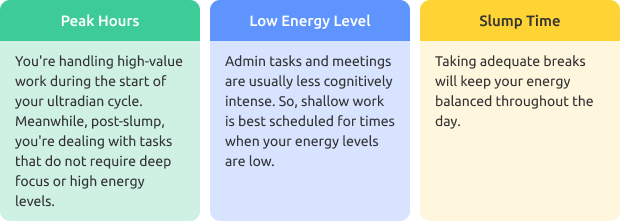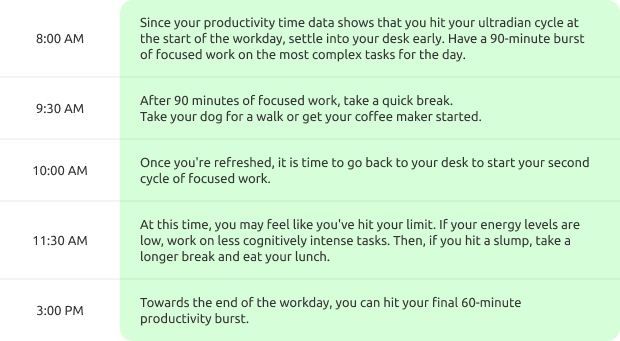We all want to be productive throughout the day. Once we get to our desks, we hope that we can type non-stop and power through our tasks. Unfortunately, achieving productivity is a lot harder than it sounds. Most of us experience peaks and valleys in creativity. The truth is, you still need those low points. They are your brain and body’s way of saying that you need a break.
You cannot and should not get rid of less productive times of your day. However, it is important for you to recognize when you tend to give your optimum performance. Of course, time management strategies always play an important role in helping you achieve your goals. However, by knowing your most productive time of day to work, you can give yourself a boost.
Everyone Has Their Peak Time
Your body has a group of cells that communicate the time of day to other parts of your organism. Also known as the ‘body clock’ genes, these cells can affect your alertness and energy. They identify the times of day when you can give your best performance. At the start of the peak cycle, you may experience increased focus and energy. However, towards the end of this period, you may begin to feel fatigued. Moreover, your brain may be all over the place.
If you are a morning person, you can power through tasks in the AM. However, evenings will always be a struggle. It’s important to understand how your body reacts to work depending on the time of day. This way, it will be easier for you to determine when to focus on difficult tasks. You will know the best times to brainstorm and when you shouldn’t attend or hold meetings.
The Ultradian Cycle
Steve Kay, a molecular and computational biology professor at the University of Southern California, explained why we have peak productivity times. He said that the master clock of our body synchronizes our cardiovascular, metabolic, and behavioral rhythms. Kay added that our body does this in response to light and other natural stimuli. When this happens, we gain an edge in our daily lives.
Because of our internal clock, our body naturally knows when to wake up, sleep, and become alert. Our peaks and valleys tend to happen around the same time each day. The times may vary for every person, but the cycle is something that all of us experience. The 24-hour cycle is known as a circadian day.
Now, within the circadian cycle, we go through 90-minute periods of heightened focus and productivity. These bursts of energy are called the ‘ultradian cycle’. The beginning of each cycle is when your brain is performing at its best. However, as the cycle runs, your energy depletes. You can still work at the end of each ultradian cycle, but you won’t have the same efficiency. After all, your brain needs to refresh and rest.
Pushing through your downtime will mean forcing yourself to work in non-optimal conditions. As such, researchers suggest taking a different approach. Studies suggest that finding your personal ultradian cycle will help you tackle difficult projects efficiently. During your most productive time of day, you can deal with complex tasks that require problem-solving, strategizing, and extensive creativity. Meanwhile, you can reserve routine activities for your ultradian valleys.
How to Figure Out Your Peak Times
It’s easy to say that you’re a morning person or a night owl. However, it takes a systematic approach to identify the times of day when you are most efficient. Indeed, you can try monitoring your mood and focus and rely on self-reporting. However, there is an easier and more accurate way to track your behavior. You can use a productivity time tracker like Traqq. Here are some of the ways this tool can help you:
Collate Accurate Productivity Data
Traqq is free for download, so anyone can use it. Once you’ve installed it and clicked the Start button on the widget, it will start collecting data on the websites you’re visiting and apps you’re using. What’s more, it will monitor your activity levels and show you whether you’ve been productive throughout the day. After a week of using the tool, you can generate a raw report of your performance. The report can be exported as a .csv file, making it easier to process the data.
You can also look at the dashboard and review your activity levels for the week. They are color-coded according to the amount of work you do. Minutes with high activity levels are green, normal activity is marked in yellow, and low activity is red. After a week of gathering data, you will notice a pattern of when your energy, focus, and enthusiasm appear lowest and highest. Keep on collating your productivity information, and after a few weeks, you will have clear indicators of your peak times.
Analyze Your Data
At this point, you already know the times of day when your focus and energy are at their highest levels. Now, it’s up to you to optimize your schedule for uninterrupted work and creativity. Time blocking is one of the best ways to schedule your tasks according to your ultradian cycle. Here’s how you’d want to organize your tasks:

Time blocking allows you to create dedicated “periods” for every type of activity. This scheduling technique lets you plan your ideal day before it begins. As such, you won’t be caught off-guard by interruptions and distractions. There are various reasons why this type of scheduling works:

To make things easier for you, we’ll show you what an ideal ultradian cycle workday would look like. In the example below, the cycle begins at the start of the day:

Expect to Be Interrupted
Even though you’ve carefully organized your day around your ultradian cycles, things will not go perfectly as you planned. From time to time, you may still get interrupted, and these forces are beyond your control. Remember that discovering your peak productivity times is only half the battle. Your focused work can be disrupted by rowdy kids (if you work from home), annoying coworkers, and phone calls. Accept that there are times when you can’t always get as much work done as you’d like.
One of the best tips for self-improvement is to identify your ultradian cycles and optimize your tasks and activities around them. If coworkers tend to be chatty around the afternoon, then schedule your less cognitively intense tasks for that time. If your first ultradian cycle happens in the morning, avoid cyberloafing and start working on important projects.
The Bottom Line: Work Smarter, Not Harder
Keep in mind that your goal is to ensure optimal productivity during your peak times. During times when you’re less efficient, you should downshift. Becoming efficient does not mean that you are trying to work faster or more hours.
